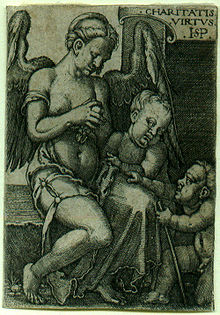Sebald Beham: Difference between revisions
Nick Michael (talk | contribs) + image |
m →Work: sp |
||
| Line 17: | Line 17: | ||
The book on the proportions of the horse, for which he was exiled in 1528, was an artist's manual, later followed by one on the human figure. These were simplified borrowings of Dürer's works on the subjects, but rather easier to use (and cheaper), so they had a long-lasting success among artists. |
The book on the proportions of the horse, for which he was exiled in 1528, was an artist's manual, later followed by one on the human figure. These were simplified borrowings of Dürer's works on the subjects, but rather easier to use (and cheaper), so they had a long-lasting success among artists. |
||
His engravings cover a range of subjects, but he is especially known for scenes of peasant life, and scenes from classical myth or history, both often with an erotic element. His early work was done under the shadow of Dürer, who was still working in Nuremberg, and one early |
His engravings cover a range of subjects, but he is especially known for scenes of peasant life, and scenes from classical myth or history, both often with an erotic element. His early work was done under the shadow of Dürer, who was still working in Nuremberg, and one early woodcut "Head of Christ", to which the AD monogram was added in the 2nd [[state (printmaking)|state]] (probably not by Beham), was long believed to be a work by Dürer by [[Adam Bartsch]] and others. He also borrowed from his brother Barthel's rather more original works. In his later work he boldly re-interpreted many of Dürer's most famous prints in works like his Melancholia of 1539 that exploit the difference in scale between his work and the original. |
||
=== Sigismund bell === |
=== Sigismund bell === |
||
Revision as of 08:47, 26 August 2008

Hans Sebald Beham (1500 – 1550) was a German printmaker who did his best work as an engraver, and was also a designer of woodcuts and a painter and miniaturist. He is one of the most important of the "Little Masters", the group of German artists making old master prints in the generation after Dürer.
Life

The older brother of Barthel Beham by two years, he was born into a family of artists in Nuremberg. In 1525, along with his brother and Georg Pencz, the so-called "godless painters", he was banished from Nuremberg, accused of heresy (against Lutheranism), blasphemy and not recognising the authority of the City council. Within months the three were allowed to return to the city, but Beham was exiled again in 1528 for publishing a book on the proportions of the horse regarded as plagiarised from an unpublished manuscript by Albrecht Dürer, who had recently died. After a period spent working in various German cities, from 1532 he lived mostly in Frankfurt until his death in 1550.
He is increasingly known just as "Sebald Beham", as this how he usually signed his name in full. The "Hans" seems to derive from the first letter of his monogram only. However, up to about 1532 his prints were monogrammed 'HSP', reflecting the Nuremberg pronunciation of his name: Peham. After this date, when he had moved to Frankfurt, his monogram became 'HSB'.

Work
Beham is best known as a prolific printmaker, producing approximately 252 engravings, 18 etchings and 1500 woodcuts, including woodcut book illustrations. He worked extensively on tiny, highly detailed, engravings, many as small as postage stamps, placing him in the German printmaking school known as the "Little Masters" from the size of their prints. These works he produced and published himself, whilst his much larger woodcuts were mostly commissioned work. The engravings found a ready market among German bourgeois collectors, but were not much seen in Italy. He also made prints for use as playing cards, wallpaper, coats of arms, and designs for other artists, including many designs for stained or painted glass. He also illuminated two prayer books and painted a table top (now in the Louvre ) for Cardinal Albrecht, Archbishop of Mainz. He used the monogram HSP until about 1532, and HSB thereafter.

The book on the proportions of the horse, for which he was exiled in 1528, was an artist's manual, later followed by one on the human figure. These were simplified borrowings of Dürer's works on the subjects, but rather easier to use (and cheaper), so they had a long-lasting success among artists.
His engravings cover a range of subjects, but he is especially known for scenes of peasant life, and scenes from classical myth or history, both often with an erotic element. His early work was done under the shadow of Dürer, who was still working in Nuremberg, and one early woodcut "Head of Christ", to which the AD monogram was added in the 2nd state (probably not by Beham), was long believed to be a work by Dürer by Adam Bartsch and others. He also borrowed from his brother Barthel's rather more original works. In his later work he boldly re-interpreted many of Dürer's most famous prints in works like his Melancholia of 1539 that exploit the difference in scale between his work and the original.
Sigismund bell
Hans Sebald Beham is not to be confused with Hans Beham (or Behem or Böhm), also of Nuremberg, and a contemporary, who cast the "Sigismund" bell (Zygmunt) at the Wawel castle in Poland for the Polish king Sigismund I the Old. [1]
